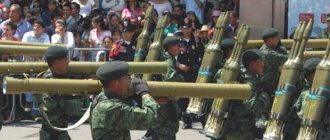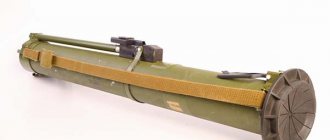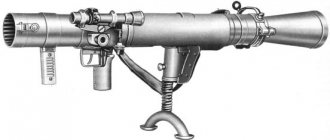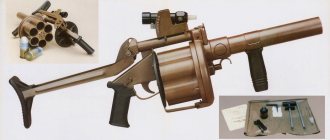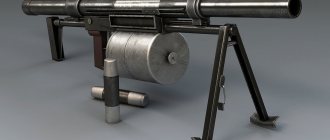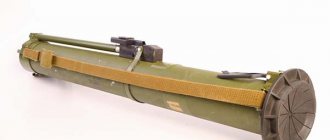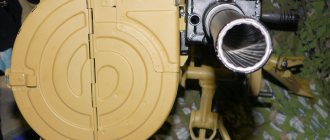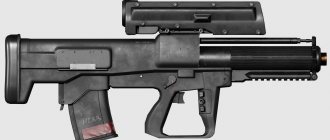Grenade launcher DP-64 "Nepryadva"
DP-64
The hand-held anti-sabotage grenade launcher system DP-64 "Nepryadva" is designed to protect ships from attacks by combat submariners in external roadsteads, open anchorages and bases, to protect against attacks by combat submariners on hydraulic structures, offshore platforms and other important marine and coastal objects. Included in the ammunition load of combat surface and underwater ships and boats.
The DP-64 grenade launcher was developed in 1989 at the Design Bureau of the Machine-Building Plant named after. V.A. Degtyarev (later - OJSC "Plant named after V.A. Degtyarev" / "ZiD"; located in the city of Kovrov, Vladimir region) as part of the theme of development work on the creation of a new generation of marine anti-sabotage weapons under the code "Nepryadva" (from - why there is a common misconception that “Nepryadva” is the “proper name” of the DP-64 grenade launcher).
DP-64 during firing
The complex consists of a double-barreled grenade launcher with vertical barrels and grenades for it - light SG-45 and high-explosive FG-45.
The DP-64 grenade launcher operates according to the design of a dynamo-reactive grenade launcher and provides single firing of grenades.
The main part of the DP-64 is a block of two thin-walled, smooth barrels 600 mm long, fixed in the breech and fastened with a sighting coupling in the middle and a clamp at the muzzle ends. The barrels are locked with a bolt with a voluminous rubber butt plate on the shoulder rest. At the bottom of the barrel block there is a front handle for holding the grenade launcher when firing and a rear handle with a trigger closed by a bracket. At the top of the bolt there are locking and cocking levers. At the top of the sighting coupling, on the left, there is a quadrant sight.
| DP-64 "Nepryadva" |
By pressing the locking lever, the barrels are unlocked, the bolt is able to move back with the spent glasses or shots removed from the barrels (when unloaded). When the shutter is turned at the end of the stroke, the short glasses fall out under their own weight. Long shots are fired by hand. Loading is done in reverse order.
The DP-64 Nepryadva grenade launcher fires from each barrel in turn.
DP-64 during reloading
Before loading, after receiving data on the range, course and depth of the target from target designation means, the grenade is set to a shallow or large explosion depth by turning the cap, after which the cap is removed from the grenade (with it the grenade will not fit into the barrel).
When an FG-45 high-explosive grenade explodes underwater, an acoustic wave affects everything in a sphere with a radius of 14 meters. Considering that the radius of the sphere of underwater destruction is 14 m, it is easy to calculate that when installing a fuse at a shallow depth, the problem of hitting a combat swimmer in the water column from the surface to 28-30 m is solved, and when installed at a deep depth, the same affected layer and overall depth are added lesions reach almost 60 m.
The SG-45 grenade is designed to illuminate and indicate the location of a combat swimmer.
When the SG-45 hits the water, it fires an expelling charge, which pushes a pyrotechnic torch out of the grenade. The torch floats to the surface and burns bright red, illuminating everything around.
| DP-64 with FG-45 and SG-45 shells |
| Caliber, mm | 45 |
| Length, mm | 820 |
| Barrel length, mm | 600 |
| Weight without grenades, kg | 10,0 |
| Grenade weight, kg | 0,65 |
| Depth of destruction of FG-45 under water, m | 40 |
| Burning time of the SG-45 grenade, s | 50 |
| Sighting range, m | 400 |
The fuse on the DP-64 Nepryadva grenade launcher is mechanical; when turned on, it blocks the trigger. The safety box is located in front of the trigger guard.
The sight is sectional, with a division step of 50 meters.
The DP-64 grenade launcher was put into service (initially by special-purpose units of the state security forces of the KGB of the USSR) in 1990.
The grenade launcher was not put into mass production, but was periodically produced in small batches to arm the crews of ships and boats, naval units of the Marine Corps and PDSS detachments (anti-sabotage forces and means) of the Russian Navy, ship and boat personnel of the naval guard of the FSB Border Service, as well as some parts of the FSO. It is also offered for export, but there is no information about any deliveries of this kind.
| DP-64 "Nepryadva" |
Indicator-signaling device DP-64
Perhaps for this thread, I will organize an entire section on the site. There would be time for creativity, and there is always a desire to share knowledge. And so, let's go. I came across this device on the Internet, and I decided to tell you about it. After the collapse of the USSR, a huge number of such and similar dosimeters are collecting dust in warehouses and bomb shelters. And, of course, he wanders around flea markets. Most of them use radioactive sources like B-8 or similar for calibration, located directly in the device body. And so, indicator-signaling device DP-64
PURPOSE:
The indicator - signaling device DP-64 is designed for continuous radiation monitoring and warning of radioactive contamination of the area.
CONTENTS OF DELIVERY:
1. Alarm panel.
2.Sensor with flexible cable.
3.Power cable.
TECHNICAL CHARACTERISTICS OF THE DP-64 INDICATOR-ALARM:
| Options | Values |
| The device operates in tracking mode and provides sound and light alarms when the level of gamma radiation, r/h is reached | 0,2 |
| The sensor is placed near the entrance to the shelter or air intake from the ground surface at a height, m | 1 |
| The device is powered from an alternating current mains voltage, V | 220/127 |
| The device is powered from DC batteries with voltage, V | 6 |
| Preparation time, after turning on the device, seconds. | 30 |
| Device weight, kg | 5 |
| Set weight, kg | 10,5 |
USER MANUAL
- PREPARING THE DEVICE FOR OPERATION
During operation, connect the device remote control only to the sensor whose number is indicated in the form. Before turning on, check the position of the controls, which must be located:
a) toggle switch “ON - OFF” - to the “OFF” position;
b) toggle switch “WORK-CONTROL” - in the “WORK” position. Depending on the power source used, connect the appropriate terminals of the power cable to the source. Set the mains voltage switch (when powered from an AC mains 127/220 V, 50 Hz) to the position corresponding to the supply voltage. Toggle switch "ON - OFF" turn on the device and check its functionality. The operation of the device is checked by switching the “WORK-CONTROL” toggle switch to the “CONTROL” position when the power is turned on. The inclusion of sound and light alarms indicates the operability of the device. Set the “WORK-CONTROL” toggle switch to the “WORK” position. The device is ready for use. To turn off the device, toggle switch “ON-OFF.” set to the “OFF” position.
- OPERATING PROCEDURE
After checking the functionality of the device, you can start working. Toggle switch "ON-OFF" should be in the “ON” position, the “WORK-CONTROL” toggle switch should be in the “WORK” position. After a signal about radioactive contamination appears, turn off the device. In the future, control for the presence of infection should be carried out by briefly turning on the device. The appearance of periodic flashes of the indicator light indicates that in a given location the exposure dose rate reaches 0.2 r/hour. As the gamma radiation dose rate increases, the frequency of flashes of the indicator light increases. When the device is operating in tracking mode, monitor operation once a day.
- OPERATION CONTROL
Monitoring the performance of the device is carried out in the following order:
— turn on the device;
— switch the “WORK-CONTROL” toggle switch to the “CONTROL” position. In this case, the signal light should flash, and the sound signal should give characteristic clicks. The frequency of light and sound alarms of a working device should be 3-12 times every 5 seconds.
- MAINTENANCE OF THE DEVICE
Maintenance is carried out in order to maintain the technical serviceability of the device and consists of systematically checking its technical condition and performing work to eliminate deficiencies related to routine repairs. Maintenance is divided into routine and periodic. Routine maintenance consists of checking the availability and safety of property, checking the operability of the device and performing work related to the routine repair of the device. Periodic maintenance includes all elements of routine maintenance and checking the calibration (operation threshold).
The calibration is checked:
a) at least once every six months in conditions of constant operation of the device;
b) when diagnosed with long-term snoring, if more than six months have passed since the last calibration check; c) when repairing or replacing the main parts and components of the circuit (gas-discharge meter, neon lamp, resistances R6, R7, etc.). The instrument calibration is checked using a Co60 gamma source. The measurement of the exposure dose created by the power source must be carried out on an installation certified according to a standard device. The alarm threshold is adjusted at the point 0.1 p/hour.
The calibration is checked in the following sequence:
— turn on the device, set the “WORK-CONTROL” toggle switch to the “WORK” position;
— install the sensor at a distance from the cobalt-60 gamma source corresponding to the exposure dose rate of 0.1 r/hour. In this case, sound and light alarms should operate at a frequency of 3-12 clicks (flashes) per 5 seconds. The alarm should start working in about 3 seconds from the start of sensor irradiation. When using a Co 60 source, the device sensor is installed from the source at a distance of at least 50 cm.
When using a standard Co 60 source to check the calibration, the distances from the source to the center of the meter are calculated using the formula:
Where:
P1—exposure dose rate;
R1 is the distance indicated in the passport for the reference source;
P2 is the exposure dose power created at the sensor locations;
R2—distance from the source to the counter axis.
If, when checking the calibration of the device, the alarm frequency differs from the nominal value (3-12 flash clicks in 5 seconds), it is necessary to make adjustments using potentiometer R7 to achieve the desired alarm frequency. After checking the calibration, the operability of the device is checked, and if necessary, by shifting the source screen located in the sensor, the required alarm frequency should be achieved in the “CONTROL” position of the “WORK-CONTROL” toggle switch. Record the results of the calibration check and periodic maintenance in the form. Setting up the device Setting up and calibrating the device should be done in normal climatic conditions during medium and major repairs of the device.
Note:
Normal climatic conditions are considered:
— ambient air temperature +25±10°С;
— atmospheric pressure 750±30 mm. Hg Art.;
— relative humidity 65±15 percent. Set the ON-OFF toggle switch to the “OFF” position, the “WORK-CONTROL” toggle switch to the “WORK” position, the fuse holder to the “220 V” position. Connect a milliammeter to the power supply circuit of the device. Connect the power cable to a power source with a voltage of 220 V. Turn on the device. The current consumed by the device should not exceed 11 mA. Connect a static voltmeter between the anode of the zener diode L2 and the minus of the diode D11. The voltage value should be within 426:456 V. If the current or voltage value does not correspond to the above, check diodes D8:D11 and lamp L2, replace the failed element. By changing the mains voltage by ±10%, make sure that the voltage value on the static voltmeter has changed by no more than 1%. Switch off the device. Check the device in the same way at a network voltage of 127 V. The current consumed by the device should not exceed 19 mA. The static voltmeter should show the same value as with a network voltage of 220 V, and if the network fluctuates by ±10%, the change in voltage on it should not exceed 1%. Then check the device when powered by 6 V batteries. The current consumed by the device should not exceed 70 mA. A static voltmeter should show the same value as with a network voltage of 220 V. Turn off the device. Disable milliammeter and static voltmeter. The device is ready for setting up the performance monitoring circuit and calibration.
Configure the performance monitoring circuit in the following order:
— turn on the device;
- set the “WORK-CONTROL” toggle switch to the “CONTROL” position. The alarm should sound at a frequency of 3-12 clicks per 5 seconds. If the alarm frequency is outside these limits, then the required value must be achieved by shifting the screen along the axis of the beta source.
On the water, please!
“In 2014, we received a substantial order from the Ministry of Defense; I cannot say now about its exact volume and to which units it will be supplied, but we are talking about the Navy,” a representative of the enterprise told RIA Novosti.
The DP-64 Nepryadva grenade launcher has no analogues in the world. Its uniqueness lies in its ability to fire from the side of a ship at underwater targets. The grenade launcher is designed to protect ships from attacks by combat swimmers in external roadsteads, open anchorages and bases, as well as to protect hydraulic structures, offshore platforms and other important marine and coastal facilities.
According to the developers, grenades fired from the DP-64 hit submariners and all types of light surface targets at a range of up to 500 m. In this case, the crew can organize all-round defense of the ship. Grenade launchers can be mounted on turrets and controlled remotely. Thanks to its design, the grenade launcher is a virtually silent weapon.
The grenade launcher is compact and lightweight, not exceeding 10 kg in firing position. Structurally, the weapon is a “double-barrel over-and-under.” A sight with a mechanical level allows you to fire both direct fire and mounted from a closed position. Shots from a grenade launcher are fired alternately from each barrel. Loading is carried out from the breech, while the bolt opens and grenades prepared for firing are inserted into each barrel. The grenade launcher is characterized by high operational reliability, ease of maintenance, and the ability to be used from anywhere on the ship, including from hatches and portholes, in various weather, climatic and physical geographic conditions.
The method of firing is also unique - first a signal flare is fired, which illuminates the place where combat swimmers may be for 50 seconds, and only then a high-explosive missile is sent there, which destroys enemy targets within a radius of 14 meters from the explosion site. The design of the FG-45 high-explosive grenade, which is rather a miniature depth charge, is curious. When a predetermined depth is reached, the explosive is detonated. The destruction of a saboteur is carried out not through the action of damaging elements (fragments, balls, etc.), but through the creation of a powerful acoustic wave.
We would like to add that at the exhibition in Abu Dhabi there was also a presentation of the unique Russian self-propelled anti-tank system “Chrysanthemum-S”. At the open area of IDEX-2015, a full-scale sample of a platoon commander’s 9P157-3 combat vehicle from the complex was demonstrated.
The Khrizantema-S anti-tank missile system (Western classification AT-15 Springer) is based on the BMP-3. The complex is the only one in the world capable of detecting and destroying targets without optical visibility in conditions of smoke, fog and snowfall, both day and night. The “all-seeing eye” of missiles is provided by radar and optical-laser channels. The 15 missiles included in the Chrysanthemum ammunition can hit targets at a distance of up to 6 km. At the same time, “Chrysanthemum-S” can easily move off-road at a speed of 70 km/h.
According to the estimates of the High-Precision Complexes holding company, which developed and produces the missile system, a battery of three Khrizantema-S combat vehicles is able to repel an attack by a tank company consisting of 14 vehicles, destroying at least 60% of the attacking tanks.
The DP-64 Nepryadva hand-held grenade launcher was created in 1989 and accepted into service with the Navy in 1990. Designed to combat saboteur swimmers. Over the past time, the grenade launcher has not been modernized, but is still in production and operation. The organizers sought to draw attention to this type of weapon to promote it on the world market, as a means of protecting civilian ships from maritime piracy. This has undoubtedly become relevant recently due to the increased hijackings of ships along the Somali coast. The event was attended by V.V. Korenkov. (General Director) and Sereda N.V. (Deputy Chief Designer), who demonstrated the grenade launcher in action in inert ammunition.Modern Russian anti-sabotage grenade launcher systems
The first samples of various types of anti-sabotage weapons began to enter service with the USSR Navy by the beginning of the 70s. In particular, the special forces of the Navy received at their disposal a four-barreled pistol for underwater shooting SPP-1, and a little later an APS assault rifle, which shoot underwater with special needle bullets capable of piercing even the cockpit caps of mini-submarines at close range. Anti-sabotage grenade launchers were installed on surface ships, as well as on the shore in the area of naval bases, ports, and various hydraulic structures, which are currently one of the most effective and versatile means of combating underwater saboteurs in the near zone of a protected facility.
The first model adopted by the Navy was the MRG-1 .
MRG-1 is a 7-barrel rocket launcher, consisting of a block of barrels mounted on a tripod, an autonomous power source and a cable. The grenade launcher is serviced by a crew of two people: a loader (aka gunner) and an operator who directly fires the grenade launcher.
Thanks to its light weight (about 60 kg), as well as its block design, which allows it to be disassembled, the grenade launcher can be quickly installed in a matter of minutes in a specially designated area on the deck of a ship or on the shore and prepared for firing.
The grenade launcher's firing circuit is activated remotely, from a distance of up to 30 m from an autonomous power source, thanks to which it can be installed in any position, including those without a stationary power source.
In order to increase the zone of destruction of underwater saboteurs when firing in one gulp, the barrels of the grenade launcher are located in the block not in parallel, but somewhat apart to the sides in such a way that each of them shoots at its own, strictly defined point in a given zone.
The grenade launcher fires 55-mm high-explosive rocket-propelled grenades, which in appearance resemble miniature depth charges and consist of a jet engine with a ring stabilizer and a warhead with a fuse. The front part of the fuse has the shape of a truncated hemisphere, which eliminates the ricochet of grenades when they hit the water. The fuse, which is triggered at any angle of approach of the grenade to the water, has several settings for the depth of detonation, which are set manually with a special key before loading the grenade into the barrel.
The grenade's jet engine is started from an electric igniter through the contact bars on the ring stabilizer.
A high-explosive grenade effectively hits a combat swimmer within a radius of 16 m throughout the entire range of depths where he can be found. Firing in one volley at a previously detected target is especially effective. At the same time, the affected area increases sevenfold.
At the end of the 70s, the DP-61 , firing the same 55-mm rocket-propelled grenades as the MRG-1. Unlike the MRG-1, it is operated by one person and can be used from anywhere on the ship’s deck except enclosed spaces, as well as by coastal patrols. However, the effectiveness of its use against underwater saboteurs was low.
At the turn of the 90s, a new generation of anti-sabotage grenade launcher weapons was created. DP-65 was developed , which includes a grenade launcher, a power panel and a control unit.
Unlike the MRG-1, the DP-65 grenade launcher is equipped with vertical and horizontal guidance mechanisms, thanks to which it can be aimed at a target from a control panel remotely from a distance of up to 100 m. Firing is also carried out from the control panel: alternately from each of the 10 barrels or in one gulp. Moreover, the control panel allows you to alternately control four grenade launchers. The grenade launcher fires using the same 55-mm grenades, which are supposed to be replaced in the future by more effective ones in terms of firing range, depth and damage radius.
The DP-65 grenade launcher is intended mainly for placement on large surface ships and vessels, as well as at various coastal facilities, and can be effectively used against various types of underwater sabotage forces and enemy assets.
However, along with high combat qualities, the above samples of anti-sabotage grenade launcher weapons have one significant drawback, which is most manifested on ships and vessels of small displacement. Such a disadvantage is the presence of a dangerous zone behind the breech of the grenade launcher barrels within a radius of up to 30 m, resulting from the operation of grenade jet engines. It is not possible for people to be in this area; instruments and critical units and mechanisms must be protected by heat-resistant casings. It is not always possible to comply with these restrictions, as a result of which the range of firing angles of the grenade launcher is sharply reduced. For this reason, it is also not possible to use the DP-61 hand grenade launcher for firing from enclosed spaces, positions, from the control room of a submarine on the surface, etc.
This drawback is completely eliminated in the 45-mm anti-sabotage hand-held grenade launcher DP-64 , which was developed to replace the DP-61.
The design of the DP-64, unlike its predecessors, uses an active grenade launch system, due to which the grenade launcher has a closed breech. This circumstance significantly expands the range of combat use of the grenade launcher. It can be fired like a regular small weapon from anywhere on the deck of a ship, from the control room of a submarine, or from a helicopter. Thanks to its original design, the grenade launcher is a virtually silent weapon, which is of great importance when used in a port or base. Unlike the DP-61, the new grenade launcher has 2 barrels with a caliber of 45 mm, which significantly increases the rate of fire (up to 5...6 rounds per minute), and, consequently, the effectiveness of defeating underwater saboteurs. Like its predecessor, the DP-64's ammunition load includes two types of grenades: signal, designed to indicate the location of underwater saboteurs, and high-explosive, to destroy them.
To transfer the fuse from the traveling to the combat position and to set the detonation depth in these grenades, no special key is required; this operation is carried out by removing the protective cap from the fuse body. The nature of the action on the target of 45-mm grenades is similar to rocket-propelled ones. In the future, it is planned to additionally include a fragmentation grenade and a non-lethal grenade in the grenade launcher’s ammunition, which will make them a powerful weapon for fighting pirates.
As a result of this, it will become a universal weapon, capable of hitting not only underwater targets, but also openly located manpower on the surface of the water on vehicles (rubber boats, kayaks and boats) and on the shore.
Thus, modern Russian models of anti-sabotage grenade launcher weapons are capable of successfully solving problems of protecting protected objects from combat swimmers and saboteurs.
DP-64 hand-held anti-sabotage grenade launcher
Designed to protect ships, surface objects, ports and coastal structures from combat swimmers (CF).
The FG-45 high-explosive grenade is designed to destroy combat swimmers (CF). The SG-45 signal grenade is designed to indicate the location of combat swimmers (FS).
Basic characteristics of DP-64
Caliber, mm
| 45 | ||
| Number of trunks, pcs | 2 | |
| Grenade launcher weight, kg | 10 | |
| Maximum firing range, m | 400 | |
| Grenade caliber, mm | FG-45 45 | SG-45 45 |
| Grenade weight, kg | 0.65 | 0.65 |
| Depth of damage to BP, m | up to 40 | |
| Radius of the affected area of the BP, m | 14 | |
| Time to indicate target location, s | 50 | 50 |
Small-sized remote-controlled grenade launcher system DP-65
Designed to protect ships, surface objects, ports and coastal structures from combat swimmers (CF).
Preparation for shooting is carried out manually. Shooting - in one volley or single shots is carried out remotely from a distance of up to 100m. The control panel allows you to alternately control four grenade launchers.
The GRS-55 signal rocket grenade is used to indicate the location of the BP, and the RG-55M rocket-propelled grenade is used to destroy the BP.
Basic characteristics of DP-65
| Caliber, mm | 55 | |
| Weight, kg | 132 | |
| Number of trunks, pcs. | 10 | |
| Maximum firing range, m | 500 | |
| Caliber, mm | RG-55M 55 | GRS-55 55 |
| Weight, kg | 0.93 | 0.93 |
| Radius of the affected area of the BP, m | 16 | |
| Depth of damage to BP, m | up to 40 | |
| Time to indicate target location, s | 50 |
Information provided by the press service of the Federal State Unitary Enterprise "State Scientific and Production Enterprise "Basalt"



